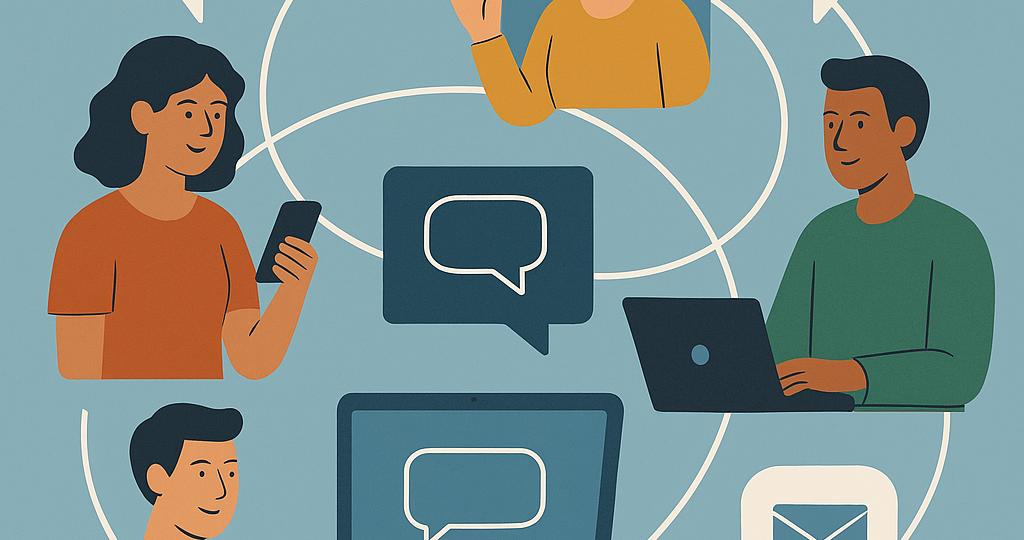
Digital Age Connections: How Technology Is Changing the Way People Interact
Introduction
The way people connect and communicate has changed more in the last few decades than in the centuries before. With the rise of digital technology, especially smartphones, the internet, and social media, human interaction has entered a new era. While technology has made staying in touch easier than ever, it has also changed the way relationships are formed, maintained, and understood. This article explores how our digital world is shaping communication and the effects it has on daily life.
Communication Without Borders
One of the biggest advantages of modern technology is instant access to others, no matter where they are. A video call to another continent, a message to a childhood friend, or a real-time group chat with colleagues across time zones — these are all normal parts of today’s life.
This kind of access has made the world feel smaller. Families stay connected across countries, businesses operate globally, and people find new friendships in online communities they might never meet in person. Whether it’s personal or professional, the ability to communicate across borders has changed expectations about availability, speed, and response.
New Ways of Building Relationships
Social media platforms have changed the definition of what it means to be “connected.” Friends, followers, and online acquaintances may outnumber face-to-face contacts for many people. People can build communities based on shared interests, not just physical proximity.
Online groups, forums, and social platforms offer space to find support, advice, and connection. From hobbyists to professionals, people are creating relationships that are just as real and meaningful as those formed in traditional settings. Technology has expanded how people find companionship, friendship, and even love.
The Rise of Digital Romance
Dating apps have revolutionized the way people meet romantic partners. With just a few taps, people can match with someone nearby or across the globe. These platforms allow users to filter preferences, chat instantly, and decide if they want to meet.
While online dating opens new doors, it also brings new challenges. Some people feel overwhelmed by choices, and others find it difficult to build trust through a screen. Still, for many, online dating offers more opportunities than traditional methods and reflects how much technology has changed our approach to love and relationships.
Effects on Social Skills and Behavior
As communication becomes more digital, the way people express themselves is also evolving. Emojis, GIFs, memes, and abbreviations are now part of everyday conversations. While these tools can be fun and expressive, they also reduce the use of body language and tone — important parts of in-person communication.
Some experts suggest that heavy reliance on texting or social media may affect how people interact face-to-face. For instance, younger generations who grew up with digital communication might feel more comfortable chatting online than talking in person. On the other hand, these tools have helped shy or socially anxious individuals connect more easily.
Attention in a Digital World
With phones always nearby, multitasking has become common during conversations. It’s easy to check a message or scroll through a feed while talking to someone. But this can lead to a lack of attention and presence, which can hurt the quality of real-life interactions.
Balancing digital life with real-world connections is important. Being present during conversations, putting phones away during meals, and setting boundaries for screen time can help maintain strong relationships.
Challenges of a Connected Society
While digital technology offers many benefits, it also presents some concerns:
1. Privacy and Oversharing
People now share more personal details online than ever before. From photos and opinions to location and activities, it’s easy to forget how public some content can be. Protecting personal information and thinking twice before posting is more important than ever.
2. Social Comparison and Mental Health
Social media often shows only the highlights of someone’s life. This can lead others to compare themselves unfairly and feel like they are falling behind. It’s important to remember that digital life doesn’t always reflect reality.
3. Digital Divide
Not everyone has equal access to technology. People in rural areas or with lower income may not have reliable internet or devices. This limits their ability to connect, learn, and grow in a world that increasingly depends on digital communication.
Finding Balance in a Digital World
Technology is a powerful tool for connection, but real human relationships still need time, care, and attention. Building trust, sharing emotions, and being present are just as important in the digital age as they were before.
Here are a few tips to maintain healthy connections in a tech-driven world:
- Set aside tech-free time during the day to focus on loved ones
- Use video or voice calls when texting isn’t enough
- Think before posting personal information
- Make time for face-to-face meetups whenever possible
- Be mindful of how much time you spend online
Conclusion
The digital age has forever changed the way people interact — often for the better. Communication is faster, more flexible, and more inclusive than ever before. At the same time, new habits and challenges have emerged. Learning how to use technology in a thoughtful and balanced way can help people stay connected while also preserving the depth and quality of their relationships.
In the end, technology should enhance human connection — not replace it.